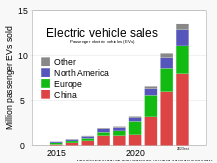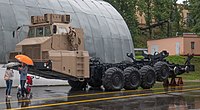
A | B | C | D | E | F | G | H | CH | I | J | K | L | M | N | O | P | Q | R | S | T | U | V | W | X | Y | Z | 0 | 1 | 2 | 3 | 4 | 5 | 6 | 7 | 8 | 9
An electric vehicle (EV) is a vehicle that uses one or more electric motors for propulsion. The vehicle can be powered by a collector system, with electricity from extravehicular sources, or can be powered autonomously by a battery or by converting fuel to electricity using a generator or fuel cells.[1] EVs include road and rail vehicles, electric boats and underwater vessels, electric aircraft and electric spacecraft.
- Electric car, a BMW i3 charging from a standard electrical outlet.
- Electric aircraft, the Solar Impulse 2, which circumnavigated the globe
- Electric boat, the Tûranor PlanetSolar, the first solar-powered boat to circumnavigate the world
- Electric high speed train, N700 Series Shinkansen of JR Central on the San'yo Shinkansen, Japan
- Battery electric bus, a BYD bus in Landskrona, Sweden
- E-bike, a Geero, with the removable battery integrated into the down tube.
- Electric truck, Class 8, a Tesla Semi in Rocklin, California
- Electric cart, an Italcar Attiva C2S.4
Early electric vehicles first came into existence in the late 19th century, when the Second Industrial Revolution brought forth electrification. Using electricity was among the preferred methods for motor vehicle propulsion as it provides a level of quietness, comfort and ease of operation that could not be achieved by the gasoline engine cars of the time, but range anxiety due to the limited energy storage offered by contemporary battery technologies hindered any mass adoption of private electric vehicles throughout the 20th century. Internal combustion engines (both gasoline and diesel engines) were the dominant propulsion mechanisms for cars and trucks for about 100 years, but electricity-powered locomotion remained commonplace in other vehicle types, such as overhead line-powered mass transit vehicles like electric trains, trams, monorails and trolley buses, as well as various small, low-speed, short-range battery-powered personal vehicles such as mobility scooters.
Hybrid electric vehicles, where electric motors are used as a supplementary propulsion to internal combustion engines, became more widespread in the late 1990s. Plug-in hybrid electric vehicles, where electric motors can be used as the predominant propulsion rather than a supplement, did not see any mass production until the late 2000s, and battery electric cars did not become practical options for the consumer market until the 2010s.
Progress in batteries, electric motors and power electronics have made electric cars more feasible than during the 20th century. As a means of reducing tailpipe emissions of carbon dioxide and other pollutants, and to reduce use of fossil fuels, government incentives are available in many areas to promote the adoption of electric cars and trucks.
History
Electric motive power started in 1827 when Hungarian priest Ányos Jedlik built the first crude but viable electric motor; the next year he used it to power a small model car.[2] In 1835, professor Sibrandus Stratingh of the University of Groningen, in the Netherlands, built a small-scale electric car, and sometime between 1832 and 1839, Robert Anderson of Scotland invented the first crude electric carriage, powered by non-rechargeable primary cells.[3] American blacksmith and inventor Thomas Davenport built a toy electric locomotive, powered by a primitive electric motor, in 1835. In 1838, a Scotsman named Robert Davidson built an electric locomotive that attained a speed of four miles per hour (6 km/h). In England, a patent was granted in 1840 for the use of rails as conductors of electric current, and similar American patents were issued to Lilley and Colten in 1847.[4]
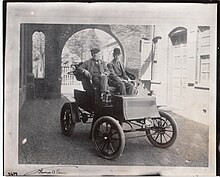
The first mass-produced electric vehicles appeared in America in the early 1900s. In 1902, the Studebaker Automobile Company entered the automotive business with electric vehicles, though it also entered the gasoline vehicles market in 1904. However, with the advent of cheap assembly line cars by Ford Motor Company, the popularity of electric cars declined significantly.[5]
Due to lack of electricity grids[6] and the limitations of storage batteries at that time, electric cars did not gain much popularity; however, electric trains gained immense popularity due to their economies and achievable speeds. By the 20th century, electric rail transport became commonplace due to advances in the development of electric locomotives. Over time their general-purpose commercial use reduced to specialist roles as platform trucks, forklift trucks, ambulances,[7] tow tractors, and urban delivery vehicles, such as the iconic British milk float. For most of the 20th century, the UK was the world's largest user of electric road vehicles.[8]
Electrified trains were used for coal transport, as the motors did not use the valuable oxygen in the mines. Switzerland's lack of natural fossil resources forced the rapid electrification of their rail network. One of the earliest rechargeable batteries – the nickel-iron battery – was favored by Edison for use in electric cars.
EVs were among the earliest automobiles, and before the preeminence of light, powerful internal combustion engines (ICEs), electric automobiles held many vehicle land speed and distance records in the early 1900s. They were produced by Baker Electric, Columbia Electric, Detroit Electric, and others, and at one point in history outsold gasoline-powered vehicles. In 1900, 28 percent of the cars on the road in the US were electric. EVs were so popular that even President Woodrow Wilson and his secret service agents toured Washington, D.C., in their Milburn Electrics, which covered 60–70 miles (100–110 km) per charge.[9]
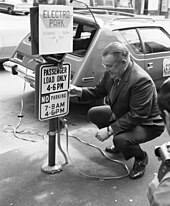
Most producers of passenger cars opted for gasoline cars in the first decade of the 20th century, but electric trucks were an established niche well into the 1920s.[10][11][6] A number of developments contributed to a decline in the popularity of electric cars.[12] Improved road infrastructure required a greater range than that offered by electric cars, and the discovery of large reserves of petroleum in Texas, Oklahoma, and California led to the wide availability of affordable gasoline/petrol, making internal combustion powered cars cheaper to operate over long distances.[13] Electric vehicles were not seldom marketed as a women's luxury car, which may have been a stigma among male consumers.[14] Also, internal combustion powered cars became ever-easier to operate thanks to the invention of the electric starter by Charles Kettering in 1912,[15] which eliminated the need of a hand crank for starting a gasoline engine, and the noise emitted by ICE cars became more bearable thanks to the use of the muffler, which Hiram Percy Maxim had invented in 1897. As roads were improved outside urban areas, electric vehicle range could not compete with the ICE. Finally, the initiation of mass production of gasoline-powered vehicles by Henry Ford in 1913 reduced significantly the cost of gasoline cars as compared to electric cars.[16]
In the 1930s, National City Lines, which was a partnership of General Motors, Firestone, and Standard Oil of California purchased many electric tram networks across the country to dismantle them and replace them with GM buses. The partnership was convicted of conspiring to monopolize the sale of equipment and supplies to their subsidiary companies, but was acquitted of conspiring to monopolize the provision of transportation services.
The Copenhagen Summit, which was conducted in the midst of a severe observable climate change brought on by human-made greenhouse gas emissions, was held in 2009. During the summit, more than 70 countries developed plans to eventually reach net zero. For many countries, adopting more EVs will help reduce the use of gasoline.[17]
Experimentation

In January 1990, General Motors President introduced its EV concept two-seater, the "Impact", at the Los Angeles Auto Show. That September, the California Air Resources Board mandated major-automaker sales of EVs, in phases starting in 1998. From 1996 to 1998 GM produced 1117 EV1s, 800 of which were made available through three-year leases.[18]
Chrysler, Ford, GM, Honda, and Toyota also produced limited numbers of EVs for California drivers during this time period. In 2003, upon the expiration of GM's EV1 leases, GM discontinued them. The discontinuation has variously been attributed to:
- the auto industry's successful federal court challenge to California's zero-emissions vehicle mandate,
- a federal regulation requiring GM to produce and maintain spare parts for the few thousand EV1s and
- the success of the oil and auto industries' media campaign to reduce public acceptance of EVs.
A movie made on the subject in 2005–2006 was titled Who Killed the Electric Car? and released theatrically by Sony Pictures Classics in 2006. The film explores the roles of automobile manufacturers, oil industry, the U.S. government, batteries, hydrogen vehicles, and the general public, and each of their roles in limiting the deployment and adoption of this technology.
Ford released a number of their Ford Ecostar delivery vans into the market. Honda, Nissan and Toyota also repossessed and crushed most of their EVs, which, like the GM EV1s, had been available only by closed-end lease. After public protests, Toyota sold 200 of its RAV4 EVs; they later sold at over their original forty-thousand-dollar price. Later, BMW of Canada sold off a number of Mini EVs when their Canadian testing ended.
The production of the Citroën Berlingo Electrique stopped in September 2005. Zenn started production in 2006 but ended by 2009.[19]
Reintroduction
During the late 20th and early 21st century, the environmental impact of the petroleum-based transportation infrastructure, along with the fear of peak oil, led to renewed interest in electric transportation infrastructure.[22] EVs differ from fossil fuel-powered vehicles in that the electricity they consume can be generated from a wide range of sources, including fossil fuels, nuclear power, and renewables such as solar power and wind power, or any combination of those.
The carbon footprint and other emissions of electric vehicles vary depending on the fuel and technology used for electricity generation.[23][24] The electricity may be stored in the vehicle using a battery, flywheel, or supercapacitors. Vehicles using internal combustion engines usually only derive their energy from a single or a few sources, usually non-renewable fossil fuels. A key advantage of electric vehicles is regenerative braking, which recovers kinetic energy, typically lost during friction braking as heat, as electricity restored to the on-board battery.
Electricity sources
There are many ways to generate electricity, of varying costs, efficiency and ecological desirability.
Connection to generator plants
- Direct connection to electric grids as is common among electric trains, trams, trolleybuses, and trolleytrucks (See also: overhead lines, third rail and conduit current collection)
- Online electric vehicle collects power from electric power strips buried under the road surface through electromagnetic induction
Onboard generators and hybrid EVs
- Generated on-board using a diesel engine: diesel–electric locomotive and diesel–electric multiple unit (DEMU)
- Generated on-board using a fuel cell: fuel cell vehicle
- Generated on-board using nuclear energy: nuclear submarines and aircraft carriers
- Renewable sources such as solar power: solar vehicle
It is also possible to have hybrid EVs that derive electricity from multiple sources, such as:
- On-board rechargeable electricity storage system (RESS) and a direct continuous connection to land-based generation plants for purposes of on-highway recharging with unrestricted highway range[25]
- On-board rechargeable electricity storage system and a fueled propulsion power source (internal combustion engine): plug-in hybrid
For especially large EVs, such as submarines, the chemical energy of the diesel–electric can be replaced by a nuclear reactor. The nuclear reactor usually provides heat, which drives a steam turbine, which drives a generator, which is then fed to the propulsion. See Nuclear marine propulsion.
A few experimental vehicles, such as some cars and a handful of aircraft use solar panels for electricity.
Onboard storage
| Vehicle type | Fuel used |
|---|---|
| All-petroleum vehicle (aka all-combustion vehicle) |
Most use of petroleum or other fuel. |
| Regular hybrid electric vehicle |
Less use of petroleum or other fuel, but unable to be plugged in. |
| Plug-in hybrid vehicle | Less use of petroleum or other fuel, residual use of electricity. |
| All-electric vehicle (BEV, AEV) |
Exclusively uses electricity. |
These systems are powered from an external generator plant (nearly always when stationary), and then disconnected before motion occurs, and the electricity is stored in the vehicle until needed.
- Full Electric Vehicles (FEV).[26] Power storage methods include:
- Chemical energy stored on the vehicle in on-board batteries: Battery electric vehicle (BEV) typically with a lithium-ion battery
- Kinetic energy storage: flywheels
- Static energy stored on the vehicle in on-board electric double-layer capacitors
Batteries, electric double-layer capacitors and flywheel energy storage are forms of rechargeable on-board electricity storage systems. By avoiding an intermediate mechanical step, the energy conversion efficiency can be improved compared to hybrids by avoiding unnecessary energy conversions. Furthermore, electro-chemical batteries conversions are reversible, allowing electrical energy to be stored in chemical form.[27]
Lithium-ion battery


Most electric vehicles use lithium-ion batteries (Li-Ions or LIBs). Lithium-ion batteries have a higher energy density, longer life span, and higher power density than most other practical batteries.[30] Complicating factors include safety, durability, thermal breakdown, environmental impact, and cost. Li-ion batteries should be used within safe temperature and voltage ranges to operate safely and efficiently.[31]
Increasing the battery's lifespan decreases effective costs and environmental impact. One technique is to operate a subset of the battery cells at a time and switching these subsets.[32]
In the past, nickel–metal hydride batteries were used in some electric cars, such as those made by General Motors.[33] These battery types are considered outdated due to their tendencies to self-discharge in the heat.[34] Furthermore, a patent for this type of battery was held by Chevron, which created a problem for their widespread development.[35] These factors, coupled with their high cost, has led to lithium-ion batteries leading as the predominant battery for EVs.[36]
The prices of lithium-ion batteries have declined dramatically over the past decade, contributing to a reduction in price for electric vehicles, but an increase in the price of critical minerals such as lithium from 2021 to the end of 2022 has put pressure on historical battery price decreases.[37][38]
Electric motor

The power of a vehicle's electric motor, as in other machines, is measured in kilowatts (kW). Electric motors can deliver their maximum torque over a wide RPM range. This means that the performance of a vehicle with a 100 kW electric motor exceeds that of a vehicle with a 100 kW internal combustion engine, which can only deliver its maximum torque within a limited range of engine speed.
Efficiency of charging varies considerably depending on the type of charger,[39] and energy is lost during the process of converting the electrical energy to mechanical energy.
Usually, direct current (DC) electricity is fed into a DC/AC inverter where it is converted to alternating current (AC) electricity and this AC electricity is connected to a 3-phase AC motor.
For electric trains, forklift trucks, and some electric cars, DC motors are often used. In some cases, universal motors are used, and then AC or DC may be employed. In recent production vehicles, various motor types have been implemented; for instance, induction motors within Tesla Motor vehicles and permanent magnet machines in the Nissan Leaf and Chevrolet Bolt.[40]
Energy and motors

Most large electric transport systems are powered by stationary sources of electricity that are directly connected to the vehicles through wires. Electric traction allows the use of regenerative braking, in which the motors are used as brakes and become generators that transform the motion of, usually, a train into electrical power that is then fed back into the lines. This system is particularly advantageous in mountainous operations, as descending vehicles can produce a large portion of the power required for those ascending. This regenerative system is only viable if the system is large enough to use the power generated by descending vehicles.
In the systems above, motion is provided by a rotary electric motor. However, it is possible to "unroll" the motor to drive directly against a special matched track. These linear motors are used in maglev trains which float above the rails supported by magnetic levitation. This allows for almost no rolling resistance of the vehicle and no mechanical wear and tear of the train or track. In addition to the high-performance control systems needed, switching and curving of the tracks becomes difficult with linear motors, which to date has restricted their operations to high-speed point to point services.
Vehicle types
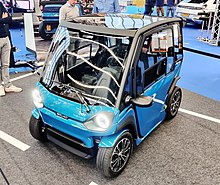
It is generally possible to equip any kind of vehicle with an electric power-train.
Ground vehicles
Pure-electric vehicles
A pure-electric vehicle or all-electric vehicle is powered exclusively through electric motors. The electricity may come from a battery (battery electric vehicle), solar panel (solar vehicle) or fuel cell (fuel cell vehicle).
Hybrid EVs
A hybrid electric vehicle (HEV) is a type of hybrid vehicle that combines a conventional internal combustion engine (ICE) system with an electric propulsion system (hybrid vehicle drivetrain). The presence of the electric powertrain is intended to achieve either better fuel economy than a conventional vehicle or better performance. There is a variety of HEV types and the degree to which each functions as an electric vehicle (EV) also varies. The most common form of HEV is the hybrid electric car, although hybrid electric trucks (pickups and tractors), buses, boats,[42] and aircraft also exist.
Modern HEVs make use of efficiency-improving technologies such as regenerative brakes which convert the vehicle's kinetic energy to electric energy, which is stored in a battery or supercapacitor. Some varieties of HEV use an internal combustion engine to turn an electrical generator, which either recharges the vehicle's batteries or directly powers its electric drive motors; this combination is known as a motor–generator.[43] Many HEVs reduce idle emissions by shutting down the engine at idle and restarting it when needed; this is known as a start-stop system. A hybrid-electric produces lower tailpipe emissions than a comparably sized gasoline car since the hybrid's gasoline engine is usually smaller than that of a gasoline-powered vehicle. If the engine is not used to drive the car directly, it can be geared to run at maximum efficiency, further improving fuel economy.There are different ways that a hybrid electric vehicle can combine the power from an electric motor and the internal combustion engine. The most common type is a parallel hybrid that connects the engine and the electric motor to the wheels through mechanical coupling. In this scenario, the electric motor and the engine can drive the wheels directly. Series hybrids only use the electric motor to drive the wheels and can often be referred to as extended-range electric vehicles (EREVs) or range-extended electric vehicles (REEVs). There are also series-parallel hybrids where the vehicle can be powered by the engine working alone, the electric motor on its own, or by both working together; this is designed so that the engine can run at its optimum range as often as possible.[44]
Plug-in electric vehicle

A plug-in electric vehicle (PEV) is any motor vehicle that can be recharged from any external source of electricity, such as wall sockets, and the electricity stored in the Rechargeable battery packs drives or contributes to drive the wheels. PEV is a subcategory of electric vehicles that includes battery electric vehicles (BEVs), plug-in hybrid vehicles, (PHEVs), and electric vehicle conversions of hybrid electric vehicles and conventional internal combustion engine vehicles.[49][50][51]
Range-extended electric vehicle
A range-extended electric vehicle (REEV) is a vehicle powered by an electric motor and a plug-in battery. An auxiliary combustion engine is used only to supplement battery charging and not as the primary source of power.[52]
On- and off-road EVs
On-road electric vehicles include electric cars, electric trolleybuses, electric buses, battery electric buses, electric trucks, electric bicycles, electric motorcycles and scooters, personal transporters, neighborhood electric vehicles, golf carts, milk floats, and forklifts. Off-road vehicles include electrified all-terrain vehicles and electric tractors.
Railborne EVs

The fixed nature of a rail line makes it relatively easy to power EVs through permanent overhead lines or electrified third rails, eliminating the need for heavy onboard batteries. Electric locomotives, electric multiple units, electric trams (also called streetcars or trolleys), electric light rail systems, and electric rapid transit are all in common use today, especially in Europe and Asia.
Since electric trains do not need to carry a heavy internal combustion engine or large batteries, they can have very good power-to-weight ratios. This allows high speed trains such as France's double-deck TGVs to operate at speeds of 320 km/h (200 mph) or higher, and electric locomotives to have a much higher power output than diesel locomotives. In addition, they have higher short-term surge power for fast acceleration, and using regenerative brakes can put braking power back into the electrical grid rather than wasting it.
Maglev trains are also nearly always EVs.[53]
There are also battery electric passenger trains operating on non-electrified rail lines.
Seaborne EVs

Electric boats were popular around the turn of the 20th century. Interest in quiet and potentially renewable marine transportation has steadily increased since the late 20th century, as solar cells have given motorboats the infinite range of sailboats. Electric motors can and have also been used in sailboats instead of traditional diesel engines.[54] Electric ferries operate routinely.[55] Submarines use batteries (charged by diesel or gasoline engines at the surface), nuclear power, fuel cells[56] or Stirling engines to run electric motor-driven propellers. Fully electric tugboats are being used in Auckland, New Zealand (June 2022),[57] Vancouver, British Columbia (October 2023),[58] and San Diego, California.[59]
Airborne EVs

Since the beginnings of aviation, electric power for aircraft has received a great deal of experimentation. Currently, flying electric aircraft include piloted and unpiloted aerial vehicles.
Electrically powered spacecraft
Electric power has a long history of use in spacecraft.[60][61] The power sources used for spacecraft are batteries, solar panels and nuclear power. Current methods of propelling a spacecraft with electricity include the arcjet rocket, the electrostatic ion thruster, the Hall-effect thruster, and Field Emission Electric Propulsion.
Space rover vehicles
Crewed and uncrewed vehicles have been used to explore the Moon and other planets in the Solar System. On the last three missions of the Apollo program in 1971 and 1972, astronauts drove silver-oxide battery-powered Lunar Roving Vehicles distances up to 35.7 kilometers (22.2 mi) on the lunar surface.[62] Uncrewed, solar-powered rovers have explored the Moon and Mars.[63][64]
Records

- Rimac Nevera, an electric hypercar, set 23 world speed records in one day.[65][66]
- Fastest acceleration of an electric car, 0 to 100 km/h in 1.461 seconds by university students at the University of Stuttgart.[67]
- Electric Land Speed Record 353 mph (568 km/h).[68]
- Electric Car Distance Record 1,725 miles (2,776 km) in 24 hours by Bjørn Nyland.[69]
- Greatest distance by electric vehicle, single charge 999.5 miles (1,608.5 km).[70]
- Solar-powered EV is fastest EV to go over 1,000 km without stopping to recharge, the Sunswift 7.[71] Zdroj:https://en.wikipedia.org?pojem=Electric_vehicle
Text je dostupný za podmienok Creative Commons Attribution/Share-Alike License 3.0 Unported; prípadne za ďalších podmienok. Podrobnejšie informácie nájdete na stránke Podmienky použitia.
Antropológia
Aplikované vedy
Bibliometria
Dejiny vedy
Encyklopédie
Filozofia vedy
Forenzné vedy
Humanitné vedy
Knižničná veda
Kryogenika
Kryptológia
Kulturológia
Literárna veda
Medzidisciplinárne oblasti
Metódy kvantitatívnej analýzy
Metavedy
Metodika
Text je dostupný za podmienok Creative
Commons Attribution/Share-Alike License 3.0 Unported; prípadne za ďalších
podmienok.
Podrobnejšie informácie nájdete na stránke Podmienky
použitia.
www.astronomia.sk | www.biologia.sk | www.botanika.sk | www.dejiny.sk | www.economy.sk | www.elektrotechnika.sk | www.estetika.sk | www.farmakologia.sk | www.filozofia.sk | Fyzika | www.futurologia.sk | www.genetika.sk | www.chemia.sk | www.lingvistika.sk | www.politologia.sk | www.psychologia.sk | www.sexuologia.sk | www.sociologia.sk | www.veda.sk I www.zoologia.sk











